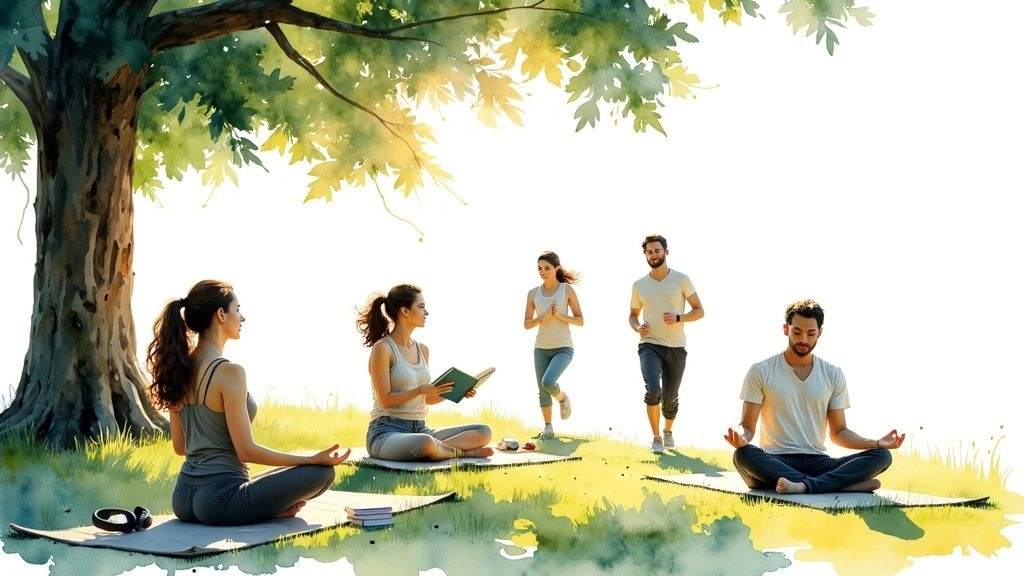8 Effective Stress Relief Activities for Students
February 20, 2025

De-Stress Your Student Life
College life often feels like a constant juggling act. Between classes, exams, friends, and maybe a part-time job too, stress seems to follow students everywhere. People have always looked for ways to find peace and calm - from ancient wisdom to modern science showing how our minds and bodies connect. While the core need hasn't changed, today's students face new kinds of pressures that make stress management essential.
What makes stress relief work? It's about finding what clicks for you personally. Maybe it's getting creative, moving your body, or simply taking a few deep breaths. The key is discovering those activities that help you feel centered and recharged, rather than just following generic advice that might not fit your needs.
We know the usual tips like "just relax" aren't enough anymore (though taking a moment to pause still helps!). That's why we've carefully selected 8 practical stress-relief activities designed specifically for busy students. These techniques will help you:
- Stay focused during intense study periods
- Feel more balanced day-to-day
- Handle academic pressure with confidence
- Actually enjoy your college experience
Whether you're a student feeling overwhelmed, or a parent or teacher looking to help, these proven strategies offer real ways to reduce stress and boost wellbeing. Skip the energy drinks and all-nighters - let's explore some better options for finding your calm. Ready to discover what works for you? Keep reading!
1. Progressive Muscle Relaxation (PMR)
Feeling stressed about upcoming exams or buried under homework? Progressive Muscle Relaxation (PMR) could help you relax and get back on track. This straightforward method lets you systematically tense and relax muscle groups to release both physical and mental tension. It's like giving yourself a tension-releasing massage that you can do anywhere.
The science behind PMR is simple - mental stress shows up as physical tension in our bodies. When you deliberately release physical tension, your mind naturally follows suit. It's an effective reset for both body and mind.
How does it work?
Picture yourself at your desk before starting a tough assignment. You start by squeezing your fists tight for several seconds, paying attention to the tension building in your hands and forearms. As you release, focus on how relaxation flows through those muscles. Moving through each muscle group from head to toe takes about 10-30 minutes. You can follow guided instructions or practice on your own.
Why include PMR in your stress-management toolkit?
The research backs it up. Created by Dr. Edmund Jacobson in the 1920s, studies show PMR helps reduce stress and anxiety. Research has found it improves sleep and helps students concentrate better. Since it needs no equipment and fits easily between study sessions, it's perfect for busy students.
A student's story:
Sarah used to get very anxious before tests. She started doing PMR regularly a few weeks before her exams. By adding short relaxation sessions to her study routine, she found she could manage her test anxiety better, focus more clearly, and perform better on exams.
Pros:
- Proven by research to lower stress and anxiety
- Better quality sleep
- Improved focus
- Easy to fit into study breaks
- No special tools needed
Cons:
- Takes time to learn properly
- Needs quiet space and some dedicated time
- May not suit everyone (check with your doctor if unsure)
Getting started tips:
- Try guided sessions first: Apps like Headspace and Calm offer guided PMR sessions perfect for beginners
- Keep a regular schedule: Like any skill, consistency helps. Try PMR before bed or during study breaks
- Find your quiet spot: Pick a place where you can focus without distractions
- Start with larger muscles: Begin with hands, arms and legs before moving to smaller muscle groups
While PMR takes some practice to master, the results make it worthwhile. For students looking to handle stress better and boost their concentration, it's a practical tool that really works.
2. Mindfulness Meditation
Need help managing your school stress? Mindfulness meditation could be just what you're looking for. This simple practice focuses on being present through breathing and observing your thoughts without judgment. Rather than trying to clear your mind completely, you learn to notice your thoughts and feelings with gentle awareness.

What makes mindfulness meditation work? Here are the key elements:
- Breath focus: Pay attention to each breath moving in and out of your body to stay grounded in the present
- Present awareness: Instead of dwelling on past or future worries, keep your attention on what's happening now
- Gentle observation: Let thoughts come and go naturally without getting caught up in them
- Easy access: Practice anywhere, anytime - perfect for a busy student schedule
Why should students try mindfulness? Research shows clear benefits:
- Better focus: Training your attention helps you stay on track during class and study time
- Less test stress: Learn to manage anxious thoughts before and during exams
- Calmer responses: Become more aware of your emotions to handle pressure better
- Deeper self-knowledge: Understanding your thought patterns leads to better self-awareness
A Brief History: Teachers like Jon Kabat-Zinn and Thich Nhat Hanh helped bring mindfulness to Western audiences. Kabat-Zinn's stress reduction program is now used worldwide, and top schools like Harvard include mindfulness in their curriculum. Medical schools have also started teaching meditation, recognizing its positive effects on wellbeing.
Ready to Start?
- Take small steps: Begin with 5 minutes daily and build up slowly
- Use helpful tools: Try Insight Timer for guided sessions that work for beginners
- Make it routine: Pick a regular time each day to practice
- Find your spot: Choose a quiet place where you can focus without interruption
Quick Summary:
Benefits: Better concentration, reduced anxiety, emotional balance, greater self-awareness
Challenges: Takes practice at first, needs regular commitment, may feel strange initially
Want to explore more mindful activities? Check out: Free Printable Mandala Coloring Pages: A Guide to Mindful Artistry. Combining meditation with creative activities like coloring can help you relax and focus even more effectively.
3. Physical Exercise

Student life comes with its share of pressures. Between classes, exams, activities, and social commitments, stress can build up quickly. That's why physical exercise is such an important way to manage student stress. The benefits go far beyond just physical fitness.
When you exercise, your body releases endorphins - natural chemicals that boost your mood and reduce stress. At the same time, physical activity helps lower stress hormones like cortisol and adrenaline. It's a simple but powerful way to reset your mind and body after a challenging day.
Types of Exercise for Students
- Cardio workouts: Running, swimming, biking, or walking get your heart rate up and improve stress management through better cardiovascular health
- Weight training: Building strength through weights, resistance bands, or bodyweight exercises builds both muscle and mental resilience
- Team activities: Playing intramural sports or joining fitness classes combines exercise with social connection
- Flexibility work: Yoga, Pilates, and stretching help release muscle tension while improving balance
Key Benefits
- Natural mood boost from endorphin release
- Better sleep with more consistent rest cycles
- Increased daily energy despite using energy during workouts
- Sharper focus from improved blood flow to the brain
Common Challenges
- Time management needed to fit in regular workouts
- Harder to maintain during busy exam periods
- Risk of injury without proper form and warmup
Getting Started Tips
- Block off workout times in your schedule like any other commitment
- Begin with 30 minutes and build up gradually
- Pick activities you like rather than forcing yourself into exercises you hate
- Use campus facilities including gyms, classes, and sports teams
Real Student Examples
Many students find success by joining running clubs, signing up for university fitness programs, or playing in recreational sports leagues. These provide built-in structure and social motivation while helping manage stress.
More and more research confirms how powerfully exercise impacts mental wellbeing. Small, consistent steps toward regular physical activity can make a big difference in handling student stress. Your mind and body will both be better for it.
4. Creative Arts Expression
Dealing with exams, assignments, and student life pressures can be a lot to handle. Creative arts offer a helpful way to manage stress and emotions by transforming them into something meaningful - whether that's a colorful painting, a piece of music, or even quick sketches in your notebook. Remember, it's not about creating perfect art - it's about the joy and relief that comes from making something.
One of the best things about creative arts is that anyone can do them. You don't need special training or natural talent to benefit. From drawing and painting to music, poetry, or clay work, there are so many ways to express yourself creatively. Whether you enjoy hands-on art, musical expression, or digital creation, you'll find something that clicks. You can join campus art groups or enjoy quiet solo creative time in your room.
The growing popularity of adult coloring books and art apps shows how much people value creative activities for stress relief. Taking a break from screens and deadlines to make art gives your mind valuable quiet time. For more ideas, check out Proven Art Therapy Activities for Anxiety & Creative Healing, which explores specific ways to use art for emotional wellbeing.
Features:
- Diverse art forms: Find the creative outlet that works best for you
- Personal expression: Share thoughts and feelings through visual art or music
- Open to everyone: No previous experience needed
- Flexible format: Create alone or with others
Pros:
- Release emotions: Process stress and feelings through creativity
- Practice mindfulness: Focus on the present creative moment
- Build confidence: Feel proud of making something yourself
- Quick stress relief: Even short creative breaks help refresh your mind
Cons:
- Supply costs: Some art materials can be expensive
- Time investment: Creative projects may take longer than expected
- Learning curve: New art skills require practice and patience
Examples:
- University art therapy: Many schools offer therapeutic art programs
- Music groups: Join bands, choirs or orchestras to connect through music
- Art journaling: Meet others who enjoy visual journaling and creativity
Tips:
- Keep supplies handy: Easy access encourages spontaneous creativity
- Find creative groups: Connect with other artistic students
- Try coloring books: An easy way to start being creative
- Explore digital art: Use drawing and design apps on your devices
Creative arts deserve attention as a powerful way to handle stress and improve wellbeing. Find the creative activities that speak to you and make them part of your routine. Pick up some art supplies, play music you love, and let your creativity flow naturally. You may be amazed by how calming and satisfying it feels to express yourself through art.
5. Time Management Techniques
Every student knows the stress of looming deadlines and endless assignments. Good time management isn't about squeezing more into each day - it's about taking charge of your schedule to accomplish more while staying calm. When students learn to manage their time well, academic stress drops significantly.
Time management works best when you create clear boundaries between study time and breaks. A good system helps you focus intensely during work periods while ensuring you get enough rest. Here are the key elements that make time management work:
- Planning Tools: Pick what works for you - from basic paper planners to digital apps. Having a clear view of your schedule helps you stay organized.
- Smart Priorities: Focus your energy on what matters most. Not every task needs equal attention - learn to identify what's truly important.
- Strategic Breaks: Regular short breaks keep your mind fresh. Plan them into your study sessions to maintain focus.
- Clear Goals: Break big projects into smaller tasks. Having realistic, achievable goals makes large assignments feel less overwhelming.
A Student's Story: Consider Sarah, who works part-time while taking a full course load. Before learning time management, she constantly felt behind and stressed. After creating a schedule with dedicated blocks for work, study, and social time, she found balance and improved her grades.
Modern Time Management: While people have always needed to manage their time, today's students have great tools at their disposal. The Pomodoro Technique uses 25-minute focus periods with short breaks to boost concentration. The Getting Things Done method helps organize tasks for better mental clarity. Many students also find motivation through "StudyWithMe" videos that show real study sessions and share practical tips.
Tips to Get Started:
- Try Digital Tools: Use Google Calendar, Trello, or Todoist to track tasks and deadlines.
- Start Pomodoro Sessions: Work for 25 minutes, then take a 5-minute break. After four sessions, take a longer 30-minute break.
- Plan Weekly: Map out your week ahead of time to see how different commitments fit together.
- Set Small Goals: Begin with tasks you know you can finish. Build up to bigger challenges as you develop better habits.
Benefits:
- Less academic stress
- Better productivity
- Healthy life balance
- No more cramming
Challenges:
- Takes consistent effort
- Habits need time to form
- May feel limiting at first
Time management helps students take control of their academic life and reduce stress through smart planning. When students learn these skills, they create a more balanced college experience and set themselves up for success in school and beyond.
6. Social Support Groups
Being a college student involves managing many emotions and pressures. Between academic demands, social life changes, and general life adjustments, stress often becomes a constant companion. That's why connecting with others through social support groups can be such a valuable stress relief activity.

Whether formal university-organized groups or casual friend meetups, these gatherings create a safe environment for students to share their experiences, discuss coping methods, and realize they aren't alone. The most helpful groups include elements like peer support, guided discussions, and personal story sharing. Some also offer professional guidance with expert tips for handling stress.
Social support groups have gained more attention as mental health awareness grows. While seeking help was once seen negatively, students now understand that reaching out shows wisdom and strength. The old model of just having resident advisors or solo counseling has expanded to recognize how valuable peer connections can be.
Pros:
- Builds Community: Support groups help create belonging, especially for students in new environments
- Offers Emotional Support: Finding others with similar challenges provides validation and comfort
- Teaches Coping Skills: Members learn practical stress management techniques from each other
- Decreases Isolation: Groups help counter the loneliness many students face during tough times
Cons:
- Time Challenges: Finding meeting times that work for everyone can be difficult
- Emotional Risk: Some find it hard to open up about personal matters
- Mixed Results: Group effectiveness depends on member dynamics and participation
Examples:
- Campus counseling groups focused on specific issues like test anxiety
- Student-run support circles for particular majors or identities
- Virtual student communities for connecting online
Tips for Getting Started:
- Find Existing Groups: Check your school's resources for established support groups
- Create Study Groups: These often naturally develop into support networks
- Use Social Media: Connect with fellow students through support-focused platforms
- Meet Regularly: Consistent gatherings strengthen group bonds
Looking for more stress relief ideas? Check out Art Therapy Group Activities. Creative activities like coloring pair well with social support to create a balanced approach to managing stress and improving wellbeing.
7. Nature Engagement
Ever felt swamped by deadlines and exams? Fresh air and greenery could be exactly what you need. Taking time to connect with nature simply means spending time outdoors in green spaces - and it has real power to reduce stress and energize your mind. Best of all, it's usually free and easy to access!
Scientists have long known about nature's calming effects, but recent research really drives home the benefits. Studies show that spending time in nature can lower stress hormones, lift your mood, and strengthen your immune system. You've probably noticed yourself feeling more relaxed after a walk in the park - there's solid science behind that peaceful feeling.
How does this natural stress relief work?
Being in nature stimulates multiple senses at once - you see the greenery, hear leaves rustling, smell the earth and fresh air. This sensory experience helps ground you in the present moment and take your mind off worries. Plus, outdoor time usually involves some physical activity, which further helps reduce stress.
Key Benefits:
- Outdoor activities: Walk, hike, or just sit quietly in nature
- Nature walks: Even a short stroll through green spaces can clear your mind
- Campus spots: Most schools have gardens or lawns perfect for study breaks
- Simple observation: Watch birds, tend plants, or just notice nature around you
Advantages:
- Lower stress hormones: Nature helps reduce cortisol levels
- Better mood: Time outdoors often increases positive feelings
- Vitamin D boost: Natural sunlight helps your body make this essential vitamin
- No cost: Most nature activities are completely free
Potential Challenges:
- Weather issues: Rain or extreme temperatures can limit outdoor time
- Distance: Some may need to travel to reach green spaces
- Scheduling: Finding time for nature with a busy course load
Research Findings:
A University of Essex study found that students in a "Green Exercise" program saw major improvements in mood and confidence. Stanford researchers also discovered that walking in nature reduced negative thought patterns that fuel stress and anxiety.
Practical Ways to Add Nature Time:
- Study outside: Find a peaceful spot outdoors for your reading or work
- Walking breaks: Instead of screen time, take quick outdoor walks between tasks
- Join groups: Connect with hiking clubs or nature organizations
- Daily routine: Set aside even 15 minutes for outdoor time - morning walks, afternoon study sessions in the park, or evening strolls work well
Nature deserves attention as a stress management tool because it offers an easy yet powerful way to boost your wellbeing. The outdoors is always there waiting to help you reset and recharge. Step outside, breathe deep, and let nature's calming effects work for you.
8. Breathing Exercises

Ever felt swamped with school assignments? Basic breathing exercises can be your secret weapon against stress. While they may seem simple, controlled breathing is one of the most effective ways to calm your mind and body during hectic student life. The best part? You can practice anywhere - in the library, before exams, or during your commute.
The science behind breathing exercises is fascinating. Your breath directly affects your autonomic nervous system, which controls vital functions like heart rate. By breathing mindfully, you can switch from a stressed state to a calmer one, leading to better focus and emotional balance.
Different breathing techniques serve different purposes. The popular 4-7-8 method involves inhaling for 4 counts, holding for 7, and exhaling for 8. This pattern is excellent for relaxation and sleep. Dr. Andrew Weil, who popularized this technique, has shown its effectiveness for stress management. Wim Hof's method takes a more energizing approach, while James Nestor's research in his book "Breath" reveals how proper breathing can improve overall wellbeing.
Features:
- Multiple techniques: Choose from calming to energizing patterns
- Quick results: Most exercises take 2-3 minutes
- Zero equipment: Just you and your breath
- Complete flexibility: Practice anywhere, anytime
Pros:
- Quick relief: Feel calmer within minutes
- Better concentration: Helps clear mental fog
- Always available: Your breath is always with you
- Research-backed: Strong scientific support
Cons:
- Initial awkwardness: Takes time to feel natural
- Needs consistency: Regular practice for best results
- Personal variation: Effects differ between people
Tips for Implementation:
- Begin with 4-7-8: Perfect for newcomers
- Try breathing apps: Calm and Headspace offer guided sessions
- Pre-test routine: Practice 5 minutes before exams
- Add visualization: Picture peaceful scenes while breathing
Consider Sarah, a student who struggled with test anxiety. After practicing breathing exercises before exams, her grades improved as she could think more clearly. Or take Mike, who felt overwhelmed by his course load. Taking short breathing breaks helped him stay focused and manage his assignments better.
Don't let the simplicity fool you - breathing exercises are a powerful tool for any student. Try them out and see how something as basic as breath can make a big difference in your academic life.
8-Point Stress Relief Comparison Matrix
| Activity | 🔄 Implementation Complexity | ⚡ Resource Requirements | 📊 Expected Outcomes | 💡 Ideal Use Cases | ⭐ Key Advantages |
|---|---|---|---|---|---|
| Progressive Muscle Relaxation | Moderate practice; requires quiet time | None; 10–30 minute session | Reduced stress and anxiety; improved sleep and focus | Solo sessions between study breaks | Science-backed; no equipment required |
| Mindfulness Meditation | Moderate; demands regular practice | Minimal; guided apps available | Enhanced concentration; reduced test anxiety and stress | Brief meditation breaks during study periods | Boosts self-awareness and emotional regulation |
| Physical Exercise | Varied; some routines may be intensive | Requires time; access to facilities or open space | Increased endorphins; better mood, energy, and cognitive function | Scheduled workouts or group sports sessions | Holistic benefits; improves physical and mental health |
| Creative Arts Expression | Low to moderate; creative flow required | May require art supplies or digital tools | Emotional outlet; mindfulness boost; enhanced self-confidence | Creative sessions or art therapy breaks | Easily accessible; encourages self-expression |
| Time Management Techniques | Moderate; habit development necessary | Digital/planning tools needed | Lower academic anxiety; higher productivity and balance | Daily scheduling and study planning | Improves work-life balance; prevents last-minute cramming |
| Social Support Groups | Depends on group coordination and dynamics | Requires peer engagement and scheduling | Provides emotional support; shared coping strategies | Organized group sessions or peer meetups | Builds community; reduces isolation |
| Nature Engagement | Simple; integrates naturally into routine | Accessible outdoor spaces; may need travel | Improved mood; reduction in cortisol levels and stress | Outdoor study breaks or nature walks | Free and accessible; boosts well-being and vitamin D |
| Breathing Exercises | Simple; quick to learn | No equipment needed; can be done anywhere | Immediate stress relief; enhanced focus | Quick breaks or pre-test relaxation sessions | Science-backed; portable technique |
Stress-Free Student Life
Managing stress takes many forms - from physical techniques like Progressive Muscle Relaxation to calming practices like meditation. We've explored ways to stay active, tap into creativity, and keep organized. The most important thing is discovering what methods work best for you personally. Not every approach will click with everyone, and that's perfectly normal. Finding your ideal stress relief strategy may take some trial and error. Think of it as building your own customized toolkit for handling life's challenges.
Developing stress management skills is an ongoing process. As you mature and evolve, the techniques that help you cope will likely shift too. What worked well in earlier school years might need adjusting later on. Stay open to exploring new approaches and refining your strategies over time.
Students today have more options than ever for personalized stress relief. Rather than a standardized approach, effective stress management focuses on finding specific tools matched to individual needs and preferences.
Key Points to Remember:
- Try Different Methods: Sample various stress-relief activities to identify what helps you most
- Give it Time: Building effective coping skills happens gradually
- Stay Flexible: As circumstances change, be ready to adjust your approach
- Make it Personal: Choose techniques that fit your individual style
Looking to add an enjoyable creative outlet to your stress-management routine? Check out ColorPageAI! Turn your imaginative ideas into beautiful coloring pages instantly. Whether you picture a breakdancing penguin or a unicorn teaching math, ColorPageAI brings your creative visions to life. It's a fun way for students of all ages (and adults too!) to unwind and express themselves through art. Start with five free coloring pages - no credit card needed. Begin creating your own stress-relieving artwork today.
Ready to start coloring?
Join ColorPage.ai today and get 5 free credits to create your own custom coloring pages!
Start creating